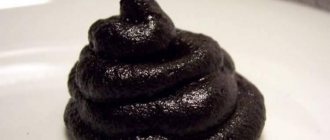What type of stool should a healthy person have?
The place where feces come from is the intestinal tract, its lower sections. Feces are the final product of food processing, the formation of which occurs under the influence of biochemical processes.
Feces appear in the large intestine from chyme, as the liquid or semi-liquid contents of the digestive tract are called, which includes food debris, gastric and intestinal juices, gland secretions, desquamated epithelial cells and microflora. As a result of the absorption of water, the lump that enters the distal sections changes its structure and turns into feces. From 400 grams of chyme, 150-200 grams of feces are formed.
The photo shows what human feces consists of.
The correct stool structure of a healthy body includes 70-75% water, mucus, and fat.
Feces contain approximately 1/3 of food residues, the same parts of the secretions of the digestive organs and microbes. Microorganisms are dead in 95% of cases.
Why feces do not sink in water is due to their structure. They are characterized by a porous structure and gas enrichment. This creates their buoyancy in the toilet. However, when the pores are filled with water, the excrement will drown after a while. Excessive buoyancy indicates an excessive concentration of fats and gases in the stool. If, on the contrary, the feces immediately sink, this indicates that they are saturated with “bad” cholesterol and toxins.
Normal feces are a sausage 10-20 centimeters long, uniform in color, composition and soft consistency. It does not contain any impurities of blood, foam, or pus. Mucus in small quantities is acceptable. Brown stool is more common.
However, the nature of stool in different people may differ from the standard, which is not necessarily a sign of pathology. Its shape, color, smell, length, diameter, thickness depend on a person’s eating habits, the amount of food and water consumed, the structural features of the intestines, diseases, and so on.
How much does feces weigh?
The weight of bowel movements in a particular person depends on the volume and quality of food and water. The latter directly affects the indicator: with constipation, the concentration of fluid in the stool is low, with diarrhea it is high, which causes weight changes. It ranges from 200 to 900 grams. The norm is calculated using the formula: 28.35 grams of feces per 5.443 kilograms of body weight. That is, the standard volume of feces for men and women weighing 72.6 kg is 454 grams.
An increase in the mass of feces (scientifically called “polyfecal matter”) occurs in pathologies associated with impaired digestion of food. Often, copious feces (weighing 1 kilogram) are released when the pancreas is damaged.
A decrease in the mass of intestinal discharge is associated with constipation or consumption of rapidly processed foods.
How many times a day should you have stool?
Bowel movements are normally carried out 1, 2 or 3 times a day, depending on the characteristics of digestion. However, there are individual standards here too. A variant of the human norm may be the act of defecation once every 3 days. Reduces the frequency of eating food of animal origin, increases - of plant origin.
The process of excreting feces in a healthy person occurs without pain (short-term spastic sensations are possible) and strong pushing, lasting 2 minutes.
The standard common frequency of stool passing is 1 time per day in the morning. If a person walks very irregularly for a long time, unstable stools (either constipation or diarrhea) are constantly observed - this is a reason to consult a doctor.
Along with the formation of feces, gas formation occurs in the intestines. Normally, 0.2-0.5 liters of gases are excreted from the body per day. When consuming certain foods (fiber, yeast, carbohydrates, etc.), overeating, or swallowing air, their quantity increases, which is accompanied by increased flatulence (the norm is up to 12 times a day).
What can the shape and size of feces indicate?
Now let's take a closer look at each of the types of poop described in the Bristol scale.
First type of stool
Individual hard balls that look like nuts are also called goat or sheep poop. Shit of this form is characteristic of acute dysbacteriosis. The first type of poop is hard and abrasive. Their dimensions are approximately 1-2 cm. Due to their hardness and prickliness, they can cause pain during fighting. With sheep poop, there is a high chance of anal canal damage and anorectal bleeding.
Second type of poop
This type of feces is a large, sausage-shaped poop with a lumpy structure. This type of feces is characteristic of constipation. The diameter of the poop is about 3-4 cm. Since the diameter of the maximum opening of the anal canal diaphragm is less than 5 cm, defecation is accompanied by damage and can cause a laceration of the anal canal. Due to being in the intestines for too long, about several weeks, the feces acquire such huge sizes. The reason for the formation of such stool can be chronic constipation, as well as hemorrhoids, anal fissures and delayed bowel movements. This type of stool can cause irritable bowel syndrome and small intestinal obstruction due to the constant strong pressure on the intestinal wall.
The third type of feces
This type of poop is similar to the previous one, with the exception of smaller sizes, about 2-3.5 cm in diameter. It has a sausage shape and cracks on the surface. A smaller diameter indicates that defecation occurs more often than with the second type. At the same time, the third type of bowel movements indicates hidden constipation. It is accompanied by minor flatulence, which is caused by dysbiosis. People with this type of stool typically suffer from irritable bowel syndrome. Such poop can cause all the adverse effects of the second type. It also contributes to a faster deterioration of hemorrhoids.
The fourth type of poop
The shape of these poops can be called a standard. The dimensions in diameter are about 1-2 cm, in length - usually within 18 cm. This type of shit is typical for defecation once a day.
Fifth type of feces
These poops are shaped like soft balls with distinct edges. The diameter of such a chair is 1-1.5 cm. Such feces are typical with 2-3 bowel movements per day. They, like the fourth type, are an excellent indicator.
The sixth type of feces
Signs of the sixth type are soft, fluffy stools with torn edges. If you can control the urge to defecate and are able to tolerate it if something happens, then this stool can be considered normal. It may characterize colon hyperactivity. The causes of such stool may include dehydration, overexertion, blood pressure, excessive sensitivity to certain spices, high mineral content in water or ingredients in food that cause a laxative effect.
Seventh type of feces
The seventh type includes loose stools, in other words diarrhea. This symbolizes diarrhea. At the same time, there may be paradoxical diarrhea. Paradoxical diarrhea is when a person has constipation and diarrhea at the same time. The lower parts of the intestine become clogged with feces, while up to 1.5-2 liters of liquid feces accumulate above them. This type of diarrhea occurs quite often, especially in young children and in weakened adults who are recovering from an illness.
As you can see, it is useful to observe the shape and size of stool. Shit can say a lot about the state of your body. Knowing the classification of feces, you can determine the normality of your stool and prevent some diseases in the early stages, as well as prevent others from developing. Of course, knowing the types of poop alone is not enough for a complete diagnosis. But enough to pay attention. We wish you stool of the correct shape. Relief!
Feces thin
Calla lilies - growing and care at home
You already know from previous articles what a normal stool should be like and what a change in its color means. Now I will tell you why it becomes thin, and what the consequences may be.
If you notice that changes have occurred and the stool appears thin, listen to your condition and watch carefully to see if additional symptoms have appeared:
- A mixture of mucus
- Streaks of scarlet blood,
- Stool became more frequent.
The presence of such additional factors clearly indicates that it is time to see a doctor. These are symptoms of diseases such as:
- Rectal polyps,
- Haemorrhoids.
Most often, these diseases do not manifest themselves for a long time and do not bother the person in any way. The only indicator of their occurrence is a change in the shape of the stool (becoming, for example, thin).
It may be objected that these diseases are not dangerous and can be easily treated. It’s absolutely not difficult to get rid of both polyps and hemorrhoids if you don’t start the process.
Both of these diseases are harbingers of colorectal cancer, and this is already a very dangerous disease
Therefore, the sooner you notice that the stool is thin, pencil-shaped, and get checked by a gastroenterologist, you will save yourself from more serious troubles.
Tape kala
Very rarely, cancerous growths grow on their own; most often they are preceded by harmless small growths - polyps. They do not cause harm and do not bother a person until they develop into a malignant tumor.
Gradually, growing, the tumor blocks the lumen of the intestine, and the output is thin feces. If you ignore this fact, after a while you will feel:
- Mild pain radiating to the sacrum
- Frequent urge to defecate,
- Constipation.
Further development of cancer will result in ribbon-like stool, increased and spreading pain, as well as the sensation of a foreign body in the rectum.
Today's medicine successfully treats colorectal cancer, but why bring the situation to such a state?
I would like to dwell on one more point. Sometimes childhood illnesses pave the way for the development of serious illnesses in adulthood. For example, lamblia.
They live and develop in the small intestine and bile ducts. By attaching to the intestinal walls, they irritate the thin mucous membrane and cause inflammation.
Constantly inflamed intestinal walls, isn’t this an excellent environment for the growth of polyps or malignant tumors?
It is almost impossible to determine the presence of Giardia without analysis; they do not manifest themselves. Parents should be alerted to poor weight gain in the child, as well as frequent attacks of nausea for no particular reason.
Fecal analysis for Giardia
Young individuals cause harm to the body, since they spend most of their lives attached to the intestinal wall. The matured form of this parasite becomes covered with a dense shell and becomes a cyst.
Unhooking from their place, they are able to “travel” through the intestines in order to attach to a new place and become an adult lamblia. The presence of cysts or adult motile individuals in the stool is indicated by a stool analysis for Giardia.
Collection rules for analysis:
For a more reliable result, you need fresh morning stool. It is collected in a special container with a preservative, received the day before at the clinic. In the laboratory, the presence of cysts is checked under a microscope. Visually detecting them is an indisputable result.
I hope I was able to convince even the most squeamish people that it is necessary to monitor the condition of your stool. If you find thin stool, do not put off visiting a doctor and check your health.
Poop. Varieties of poop
We've all been pooping since birth. That is life. Everyone eats and poops. So what people poop out, that is, poop, comes in different forms. Next we will talk about the types of poop, what to do and not do with them.
| Poop. Varieties of poop
|
Types of poop |
Ghost Poop
Occurs when you feel like you're about to poop yourself, but as soon as you rest your butt on the toilet, nothing comes out.
Turd "ghost 2"
Now you look back into the toilet to proudly contemplate your work, but the poop is already gone.
Turd "perfection"
It happens when you poop, wipe yourself and see that toilet paper is cleanliness itself, well, at least wipe your nose.
Poop "wet"
Even though you've already wiped your butt fifty times, it's still wet. And then you decide to stuff a piece of toilet paper into your panties and leave the toilet, carefully hiding your discomfort.
Turd encore
Having pooped, you already begin to pull up your pants, but exactly halfway through the process you realize that you still have something to say.
Turd "exhaustion"
It happens when a seemingly simple act turns into a process that is terrible in its excessive tension, and the veins in your neck swell and the blood rushes to your face. Clenching your fists and gritting your teeth, you almost collapse on the floor in exhaustion.
Island type turd
This happens when the pooping process becomes so large that the shit rises above the water in the toilet, forming a small mound of sushi. And you have to press the button twice so that all this mass is carried away into the sewer.
Explosive poop
This type is accompanied by the release of gases at an unprecedented level of volume, such that all the inhabitants of the rooms adjacent to the toilet are surprised: what is this, a thunderstorm or a volcanic eruption?
Alcoholic poop
Usually happens after a night of heavy drinking. It is characterized by smears that remain on the inner walls of the toilet. It is black in color, extremely smelly and has a hard consistency.
Turd “I want to, but I can’t”
When you feel that it is about to begin, and you jump onto the toilet in anticipation of happiness, but time passes, and you still can’t and in the end you decide: to hell with it, I’ll come later.
Poop "difficult birth"
When it climbs, it hurts so much that you involuntarily think that it’s nothing other than a govekha standing across the aisle.
Turd "splatter"
What comes out of us (or better yet, flies out) is a turd so heavy and so fast that when it falls into the water, it splashes on our ass, causing us to swear.
Turd "spell"
What comes out of you is an incomprehensible color, either yellow or green, which makes me think: there must be a devil in my ass.
Turd "highest color"
This is the type that doesn't smell like anything at all.
Turd "spy"
This is the case when, after pulling the rope, and it would seem, goodbye, my love, but the poop suddenly returns for no reason.
Turd "exhibition version"
Well, it is of such gigantic proportions that it is hard to believe that a human being could create such a thing. The creator has a habit of leaving his creation in the toilet so that everyone can appreciate it, and under no circumstances throws toilet paper into the toilet - God forbid it spoils or obscures his work with something.
Turd "falling apart"
It looks quite solid and solid, but as soon as you press the button, it falls apart into a thousand small pieces.
Cinnamon-colored turd
This is the case when the poop manages to stain your underwear.
Turd "stalactite"
This one comes out in one continuous mass, and no matter how hard you twist your ass, it just doesn’t want to come off. She hangs there for a few seconds, and you start shaking your thighs impatiently.
Turd "surprise"
This happens when you think you can hold it in and the toilet can wait. But... what is it? You're screwed!!!
Turd "Santa Claus"
This turd is of such incredible size that you can’t help but wonder how it will manage to get into the sewer after you press the button.
Titanic Turd
This is the type of turd that, no matter how hard you try to sink it, will still remain afloat.
Turd "rainbow"
There are at least seven different colors in this turd.
Poop “a point of pride”
You have been fighting alone with this turd for so long that when you finally manage to squeeze it out of yourself, the first thing you do is run to tell one of your friends about your battle.
Diet poop
In this case, so much crap comes out of you that you lose three kilograms of weight at once.
“Ritual” poop
It always happens at the same hour and so every day, year after year. I develop a stable habit: I can’t fall asleep unless I relieve myself at exactly 10:30 p.m.
"Growling" turd
This poop is so big that it is unlikely to come out of you until you grunt.
The poop stuck
This poop remains on the walls of the toilet, and the water does not manage to flush it away. You have to push it with a small piece of paper.
Turd "anonymous"
This one appears in the toilet in a completely mysterious way, and no one admits its authorship.
Suicide turd
This one tries to disappear down the drain before you press the button.
Musical poop
You think it's just a fart, but when you let it out, you realize that, accompanied by a musical tirade, a poop has also come out of you.
Turd "So what now?"
It happens when, having finished a task, you discover that there is no paper. And you have to use a newspaper or magazine, whatever you have in your hand, a stocking or sock, and even a cardboard tube from a roll of toilet paper, painstakingly peeling it off layer by layer, crumpling and straightening this surrogate several times in order to get at least something resembling softness and texture of toilet paper.
Poop "Pisan"
This is a hard, elongated turd that, having fallen out of the butt, “stands on the butt” and is held in this position until the very moment of draining.
Poop in milk
Due to inaccurate aiming, it does not fall into the toilet bowl and is displayed somewhere on the rim.
Turd "tenderness"
It folds itself into such an intricate pretzel that it makes you marvel at the quirks of the universe, and you urgently jump out of the closet in search of an easel with paints or, in extreme cases, a camera.
What to do with poop |
Poop should ideally be drained. But in emergency cases, they can simply be covered or buried.
What's the best thing not to do with poop? |
It is better not to touch poop with your hands. And it’s better not to eat them.
Where to get cool poop |
Eat well and you'll have great poop.
Happy pooping!
Source
How does stool disease occur?
How to store calla lilies
Even the cleanest men and women can develop Giardia. The source of infection is usually people who have these protozoa parasitizing inside their bodies. In order not to panic when making a diagnosis, you need to familiarize yourself with the signs of the disease.
Symptoms of feces
Giardiasis is a widespread protozoal disease. It is caused by the simplest single-celled organism - Giardia. It occurs both in the form of latent parasite carriage and in the form of a manifest (overt) manifestation, which is expressed in disruption of intestinal activity.
Infection occurs through the fecal-oral route. Water is considered the main link of transmission, although the transfer of harmful microorganisms can be carried out through food and dirty hands. Giardia cysts live on them from six to forty-eight hours. There is also contact infection, from one person to another.
Giardia can cause serious intestinal infections, sometimes even in the form of epidemics. In children, the disease occurs with more severe clinical manifestations.
The first sign of infection is fatty-liquid stools that last up to three days. In most patients, the disease resolves spontaneously within one to four weeks. Very often, the disease begins 7–14 days after infection and is characterized by signs of damage to the small intestine:
- Severe flatulence.
- Constant nausea.
- Discomfort in the stomach.
- Diarrhea followed by constipation.
- Spasmodic pain in the navel area.
Giardia in children, mainly of preschool age, can cause a chronic form of the disease. But usually the disease is asymptomatic or with mild symptoms.
Diagnosis of feces
Identifying giardiasis is a rather difficult task due to the multiplicity of nonspecific symptoms. They remain unchanged throughout the day and are not associated with food intake.
Among all laboratory tests, the test for Giardia antigen in feces stands out. Immunological methods (ELISA) are actively used to diagnose the disease. These test systems have very high sensitivity and specificity, allowing cysts and trophozoites to be detected in stool samples.
To perform this test, you need to collect the stool in a sterile container and deliver it to the laboratory for analysis as quickly as possible. Very rarely, it is allowed to store material for one or two days in the refrigerator at a maximum temperature of + 4°C.
Signs of unhealthy stool
Hard stool consisting of individual pieces of stool
Calla lilies description, photos of flowers, varieties for home and garden
If you find yourself staying in the toilet longer than usual because your stool consists of individual small hard rounds or sausages, pay attention to this sign. This means your body is dehydrated or constipated. Even if the stool is regular, but constantly hard, consisting of separate pieces, and difficult to move through the rectum, and effort is required to empty it, this can cause hemorrhoids
Increasing the amount of fluid consumed and foods containing fiber will help eliminate the problem. Also include magnesium-rich foods in your diet. Magnesium attracts water to the intestines, softening the stool, making it easier to pass through the rectum. In addition, it relaxes the smooth muscles of the intestinal walls, which also helps with constipation.
Black stool
The stool of newborn babies is black in the first days after birth, but soon the color becomes normal. In adults, the causes of black stool can be different: dark-colored foods (licorice, blueberries), medications containing iron, bismuth.
But if dark stool is constantly black, this may be a sign of a serious problem. For example, bleeding in the upper gastrointestinal tract due to stomach ulcers and bleeding erosions due to acid reflux, benign tumors or cancer.
If your stool is black and it is not related to food, be sure to consult a doctor!
Red or reddish-colored stool
As with black stool, red stool is not normal. This may indicate bleeding in the lower intestine, such as the colon or rectum. It can occur due to a benign tumor, cancer, inflammation of the colon (colitis), diverticulosis and even hemorrhoids.
If red stool is noticed within one to two days, there is no particular cause for concern. It can acquire this color due to certain foods: beets, cranberries, tomato juice, jelly or red drinks. But if the cause is not food, consult your doctor.
Fecal green stool
Green-colored stool most often indicates eating a lot of leafy greens or green-colored foods. Such as ice cream, brownies with green frosting, jelly beans, or candies that contain food coloring.
If you have diarrhea and green stools, this means that food is moving through the intestines very quickly, and the bile needed to break down fats does not have time to darken.
However, seaweed-colored stool may also indicate the presence of a serious infectious disease - pseudomembranous colitis. Its cause is the inadequate use of antibiotics that kill beneficial intestinal microflora, resulting in the proliferation of the microbe clostridium difficile.
Blood in stool
If you find blood in your stool, take it extremely seriously. This can be a symptom of many diseases.
Visible blood is the main symptom of rectal bleeding. Blood in stool can be bright red, red-brown, or even black. Streaks of blood in the stool may indicate hemorrhoids or anal fissures due to excessive sphincter tension due to constipation.
Among other causes of blood in the stool, the most common are stomach ulcers, colitis, inflammation of the gastric mucosa, polyps, cancer, diverticulosis, inflammatory bowel diseases, and intestinal infections. Blood in the stool is a serious reason to see a doctor.
Be afraid of black stool: dark stool and when it’s time for adults to sound the alarm
50 shades and not only gray: stool color as an important criterion for your health
What happens if you sit on the toilet for a long time, or why you can’t sit on the toilet for more than 15 minutes
If you notice that the stool has acquired a color that is not typical for it, and you have not consumed foods that can change its color, do not engage in self-diagnosis. With the help of tests and studies, the doctor will determine an accurate diagnosis and begin effective therapy. This way you can stop the development of serious diseases.
Translation and adaptation: headinsider.net / Source
What happens in the body, or what do poops say?
Authors : HealthWorks
Feces are all that remains of food eaten after the body has taken all the nutrients it needs. You DO need to go to the toilet in large quantities, as this is a natural way to get rid of waste. The color, shape, and smell of poop can tell you what's going on in your body.
Sausage-shaped, smooth and soft
Optimal view! Everything is fine!
"Sheep feces"
You lack fiber and fluid. Drink more water, eat more fruits and vegetables.
Watery, without dense lumps, liquid
You have diarrhea! Possibly caused by some kind of infection, in which case diarrhea is the body's way of getting rid of pathogens. You are advised to drink plenty of fluids to replenish fluid losses, otherwise dehydration may begin!
Sausage-shaped, but lumpy
Not as serious as in the case of “sheep feces,” but it is better to increase the amount of liquid you drink per day and the fiber you eat as part of your food.
Soft, small feces with clear edges
Not too bad. Within normal limits if you walk “large” several times a day.
Sausage-shaped, but with cracks on the surface
This is normal, but cracks mean you need to increase the amount of fluid you drink.
Spready stool with fuzzy edges
Borders on normal, but may become diarrhea.
Soft, stick-shaped stool sticking to the sides of the toilet
Having too much fat means that the body does not absorb it properly. This can occur, for example, with chronic pancreatitis.
Brown
Everything is fine. Stool is usually brown in color due to bile produced in the liver.
Green
Food may be moving too quickly through the colon. Other possibilities: You ate a lot of green leafy vegetables or green food coloring.
Black
This color may indicate that there is internal bleeding due to an ulcer or cancer. Some medications containing iron and bismuth subsalicylate may also turn stool black. Pay special attention if it is sticky, and consult a doctor if it bothers you.
Light, white or clay colors
If this is not what you usually see in the toilet, it may indicate a bile duct obstruction. Taking certain medications can also cause stool to be too light in color. Consult your doctor.
Yellow
Fatty, foul-smelling, or bright yellow stool indicates excess fat. This may be due to a fat absorption disorder such as celiac disease.
Red or bloody
Blood in the stool can be a symptom of cancer, so consult a doctor immediately.
Some facts about feces
• Food eaten typically spends 1-3 days in the human body until it turns into feces.
• Stool consists of undigested food, bacteria, mucus and dead cells, which is why it has such a specific smell.
• Healthy feces sink slowly.
How often should you go big?
On average, people relieve themselves once or twice a day, but some do it more often and some less often. According to doctors, there is no norm for going to the toilet if you feel normal.
To avoid problems with bowel movements
• Eat foods high in fiber (20-25 g, for example, 1 apple contains approximately 4 g of fiber, 1 pear - 5 g of fiber), drink more clean water, exercise regularly or exercise.
• If you have constipation, introducing a large amount of fiber into your diet will help.
• Drinking enough water makes it easier for stool to move through the rectum.
When to see a doctor?
If for the first time you see something wrong in your stool, not the same as usual, do not rush to panic. Watch. If this happens again, talk to your doctor. Pay attention to what exactly your body is “telling” you, and if something really bothers you, do not put off visiting a doctor.
Source
A stool test is like going to the hospital
Composition of human feces
75% of our feces consists of water, everything else that always has an unpleasant odor is the result of a mixture of fiber, dead and living bacteria, and mucus. Foods rich in fiber, such as beans or nuts, when ingested by the body are converted into substances that later become elements in our stool.
Other products that are more difficult to digest come out in their original form. That is why many human diseases can be determined by stool.
What does the color of feces mean?
The color of human stool can change depending on the foods we consume. Some of these can dramatically change the color of the stool, which can cause people to panic. For example, beets impart a red color, while consuming green leafy vegetables imparts a green tint.
Medications can also affect the color of stool, giving it a mostly white or clay-colored hue. A dark color may indicate bleeding in the gastric tract, or a less dangerous factor, such as taking medications with iron or activated charcoal the day before. And in any case, beware of black stool, as well as green stool in babies and toddlers!
The shape of the stool is no less important
An indicator of the ideal shape of feces is a visually small curved log that does not fall apart. Thanks to the fiber that we consume, an ideal shape is created. Thin stools can be a bad sign indicating a risk of bowel cancer. In a word, don’t rush to wash it off!
The smell of stool, or how the nose will help identify problems
Of course, the result of our stool does not have a very pleasant smell, but if you smell a strong stool smell, this indicates the presence of an infection in the body. Strong odors occur as a result of digestive problems caused by infection. This stool odor may also be associated with Crohn's disease, ulcerative colitis, and celiac disease.
Stool output is different for everyone
It often happens that you cannot go to the toilet for a greater need for several days and this is normal.
The most important thing is how consistent your bowel movements are. A decrease in the number of trips to the toilet may be caused by changes in diet or insufficient fiber.
Other causes may include various stomach or intestinal disorders.
Nationality also plays a role in the characteristics of the chair. For example, for residents of Asia it is quite normal to visit the toilet 4-5 times a day, due to their nutrition and diet, while representatives of Foggy Albion go there less often. According to statistics, the average person excretes 150 to 200 grams of feces per day, which is almost 5 tons over the course of a lifetime.
Diarrhea accelerates stool
Our body needs from 24 to 72 hours to successfully digest various elements of food, from the lightest to the heaviest. This entire load travels from the small intestine to the large intestine, exiting later through the anus.
Diarrhea, or diarrhea, leads to negative results in which the stool passes quickly through the intestines, where part of the water is absorbed. Loose stools are often caused by infection or poisoning. There are also cases in which the presence of this type of stool is the result of an allergy to certain foods.
The contents of the stool should drown the stool
If your stool floats, this indicates a high amount of fat in it. Because of this, a disorder occurs, and the complete absorption process in the intestines does not occur, in which enough nutrients and fats from food are not processed. This symptom is characteristic of chronic pancreatitis or celiac disease.
Gas during stool
Passing gas during bowel movements sounds ridiculous, but it is just a healthy and natural process. This means that beneficial bacteria break down food in the colon, releasing gas in the process. The amount of gas released from 10 to 18 times a day is considered normal for a person.
Reading on the toilet is bad for your health
Unfortunately, most people have the habit of sitting on the toilet while reading a book or magazine. According to research, there is a high probability of developing hemorrhoids or dilation of blood vessels in the anal area during bowel movements.
Your gadgets may be covered in excrement
In modern society, it is very popular to go to the toilet not with a book, but with a tablet or mobile phone
But it is important to remember that after completing the bowel movement, you must wash your hands thoroughly. Otherwise, excrement may end up on your gadgets, later getting into your food and thereby starting an infection
Here is a simple science about feces that can be easily learned and adopted. For the benefit of your health!
SaveSave
Form
The consistency and density of feces depends on the time they remain in the intestinal tract, its function and structure: with increased peristalsis, water is not absorbed sufficiently, and with slow peristalsis, it is absorbed more. In the first case, the stool will be soft or liquid, in the second - tight and strong.
Based on its physical properties, the intestines secrete mucus, which improves the passage of feces. With inflammation, abundant exudate also makes the stool have a liquid consistency. If there is a high fat content in it, the form will become ointment-like (pasty).
Mushy
Unformed feces are considered a pathological sign; they contain an excessive amount of water (90-92%). In this case, mushy stool is often heterogeneous, in the form of flakes. If small parts are mixed with abundantly secreted mucus, this means the presence of an inflammatory process.
Semi-liquid, loose stools are a consequence of increased contraction of the walls of the colon and excessive production of juice. This consistency is possible with high liquid consumption.
Thin (ribbon-like, ribbon-like)
The narrow shape of feces indicates obstacles to the passage of masses in the lower parts of the digestive tract or external pressure on the intestines. Ribbon-shaped (flat) feces are the result of spastic narrowing of the sphincters.
Such “pencil” (thread-like) stool requires diagnosis (colonoscopy), since it is considered a symptom of neoplasms.
Solid
There are many reasons for the formation of hard, dense feces:
- poor nutrition with a lack of fiber in the diet;
- little physical mobility;
- decreased motility or convulsive contractions of the digestive tract;
- increased water absorption;
- mechanical obstacles (polyps, tumors);
- inflammatory phenomena.
Hard feces are often evidence of constipation, and stool may be daily, but in small portions; there is a feeling that the bowel movement has not been completed completely.
Taking certain medications also hardens stool, making it thick and hard and difficult to pass through the intestinal tract.
Balls (peas)
This is a type of hard stool consisting of individual round lumps. Outwardly it resembles “sheep” feces.
It takes shape due to prolonged presence in the intestines as a result of constipation, dehydration, taking certain medications and strengthening products (meat, alcohol), and a sedentary lifestyle. With spastic colitis, the feces, like those of a goat, contain 60% water, which explains its tightness.











